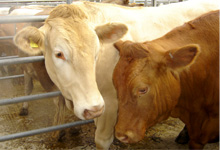
Welfare in Markets
Livestock markets have been used for selling animals for centuries. However, facilities at markets have not always provided the best conditions for protecting animal welfare. Increasingly, some livestock sectors are moving away from using markets altogether. Many pigs and poultry are now transported from farms direct to the slaughterhouse.
In the 1920s and 30s, the HSA visited many markets in the UK and found that animals suffered from exposure, lack of water and rough handling in antiquated temporary street facilities. It was clear that purpose-built markets were needed and the HSA worked with local authorities to ensure that adequate provisions were included in plans for new and renovated markets. Where necessary, the HSA gave financial support to provide calf shelters, loading bays, poultry pens and water troughs.
The HSA’s 1932 annual report stated: ‘a well-designed and properly equipped market saves time, money and food, reduces the risk of injury to the animal, and prevents bruised carcases in the case of fat stock. Sales are speeded up, the animals are shown to greater advantage and the work of the drovers rendered easier’.
| In 1932, the HSA drew up a list of minimum requirements for livestock markets. These were: |
|---|
Markets should provide:
In addition, the following rules should be rigidly observed:
|
In 1989, the HSA introduced a ‘Market Award’ to support and encourage high standards of welfare. In 1992, a video ‘To Market to Market’, together with a practical guide, was produced to aid those handling livestock, particularly in markets. The HSA also provided ‘Market Development Grants’ to help fund welfare improvements to market facilities.
The HSA has been involved in several research projects aimed at improving the welfare of animals in markets. Research has been conducted into loading facilities, lairaging and the human-animal interaction (stockmanship) in markets. The results of such research have informed HSA publications and training materials, and have been used to improve animal welfare in markets throughout the world.
Fact Sheets
Humane Slaughter Association
The Old School, Brewhouse Hill, Wheathampstead, Herts, AL4 8AN, UK
Registered Charity in England No 1159690: Charitable Incorporated Organisation. Copyright © www.hsa.org.uk.

